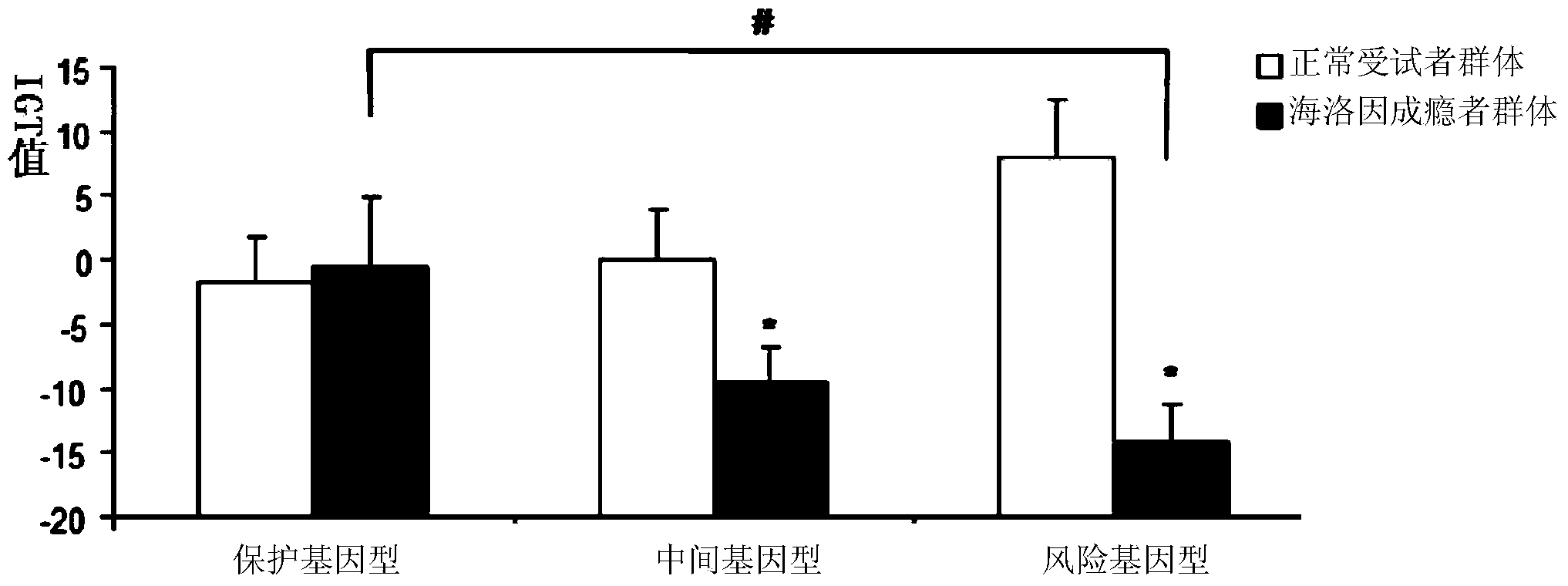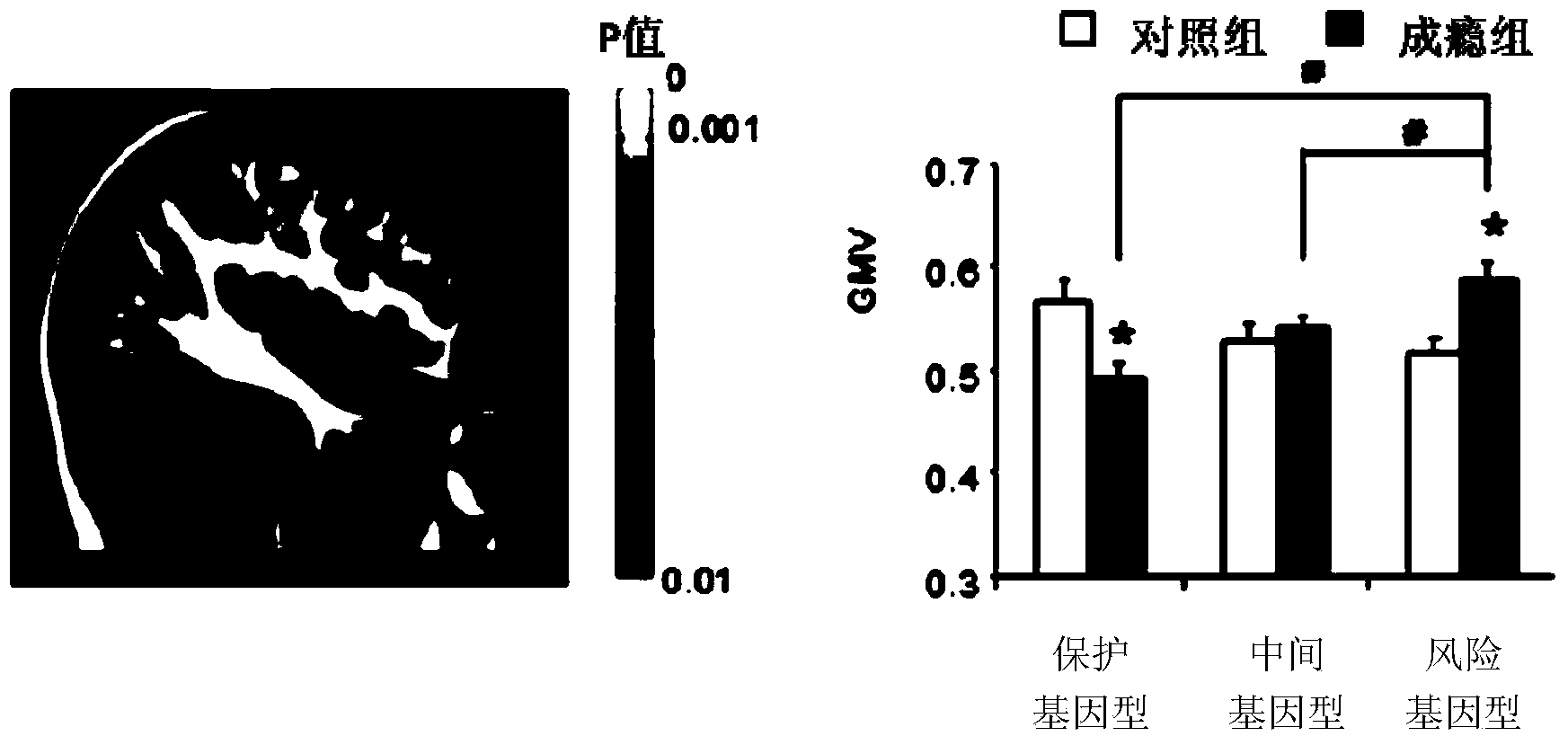Novel applications of materials for detecting nucleotides of rs7597593 site and rs1344706 site
A nucleotide and site technology, applied in the field of biomedicine where the invention belongs to, can solve the problem of unclear exact function of the ZNF804A gene, and achieve the effect of preventing heroin addiction diseases and great application value
- Summary
- Abstract
- Description
- Claims
- Application Information
AI Technical Summary
Problems solved by technology
Method used
Image
Examples
Embodiment 1
[0030] Example 1. Detecting the nucleotides at the rs7597593 site and the rs1344706 site in a subject, and obtaining the joint genotype of the subject population based on the rs7597593 site and the rs1344706 site
[0031] 1. Extract the genomic DNA from the peripheral venous blood of the subjects.
[0032] 2. Using the genomic DNA extracted in step 1 as a template, PCR amplification was performed using a specific primer pair composed of rs7597593-upper and rs7597593-lower to obtain a PCR amplification product.
[0033] 3. Sequencing the PCR amplification product in step 2, so as to know the genotype of the subject based on the rs7597593 site. The sequencing results showed that the PCR amplification products were all the target sequences in the ZNF804A gene, and there was no other non-specific amplification, that is, for the specific primer pair, there were no other amplified targets in the human genome, and the specificity good.
[0034] 4. Using the genomic DNA extracted in...
Embodiment 2
[0046]Example 2, Edward Gambling Test (Iowa Gambling Task, IGT)
[0047] Using the IGT classic card method, there are four groups of cards (A, B, C, D), each group has 40 cards, stacked according to certain rules. Among them, Group A and Group B represent high-risk cards, with high scores and higher loss points. The more you choose these two groups of cards, the lower the final total score; Group C and D are low-risk cards with low scores. There are fewer points lost, and the more cards you choose from these two groups, the higher your final total score. In the case of not knowing the score of each card in advance, the subject chooses one card from the four groups of cards at a time according to the instruction to maximize the total score, and stops when a total of 100 cards are selected. Finally, the result of selecting the total number of low-risk Group C and D cards minus the total number of high-risk Group A and B cards ((C+D)-(A+B)) represents the impulsive decision-maki...
Embodiment 3
[0053] Example 3. Combining genotypes with changes in brain images of subjects
[0054] In the Department of Imaging, Zhongshan Hospital of Traditional Chinese Medicine, Guangdong Province, a magnetic resonance scanner was used to scan the subjects' heads. Fix the subject's head with a matching foam pad, plug the ears with rubber plugs to reduce noise interference, and keep the subject at rest throughout the scanning process, lying quietly on his back with his eyes closed. A total of 2 different MR sequences (3D-T1; T2) were scanned, and each sequence was repeated. First complete the scan of the positioning image, and then perform the axial 3D-T1 spoiled gradient echo sequence (SPGR) scan, the scan parameters are: slice thickness = 1 mm, repetition time (TR) = 7.816 milliseconds, echo time (TE) = 2.984 milliseconds, inversion time = 450ms, inversion angle = 13°, matrix = 256×256, field of view (FOV) = 256×256mm 2 , the average number of times = 2. During the scanning proces...
PUM
 Login to View More
Login to View More Abstract
Description
Claims
Application Information
 Login to View More
Login to View More - R&D
- Intellectual Property
- Life Sciences
- Materials
- Tech Scout
- Unparalleled Data Quality
- Higher Quality Content
- 60% Fewer Hallucinations
Browse by: Latest US Patents, China's latest patents, Technical Efficacy Thesaurus, Application Domain, Technology Topic, Popular Technical Reports.
© 2025 PatSnap. All rights reserved.Legal|Privacy policy|Modern Slavery Act Transparency Statement|Sitemap|About US| Contact US: help@patsnap.com



